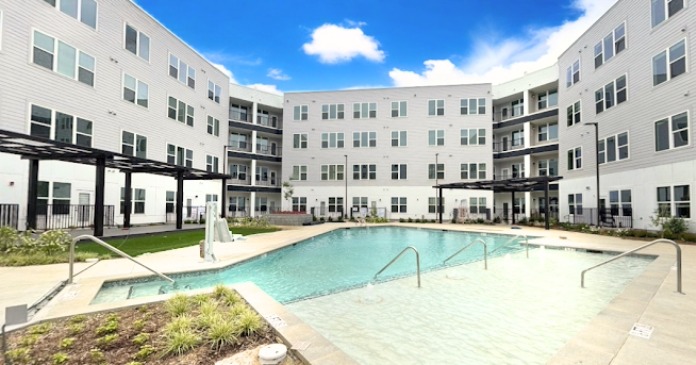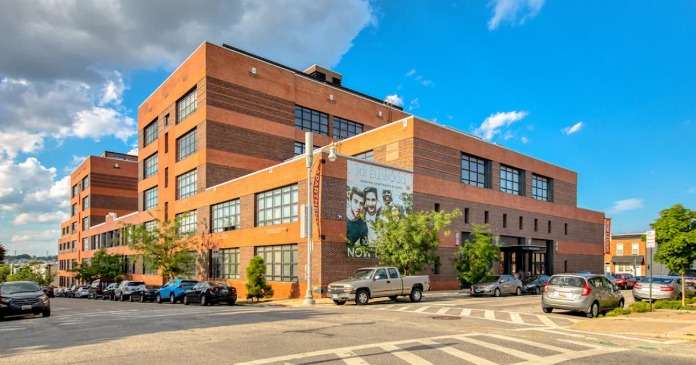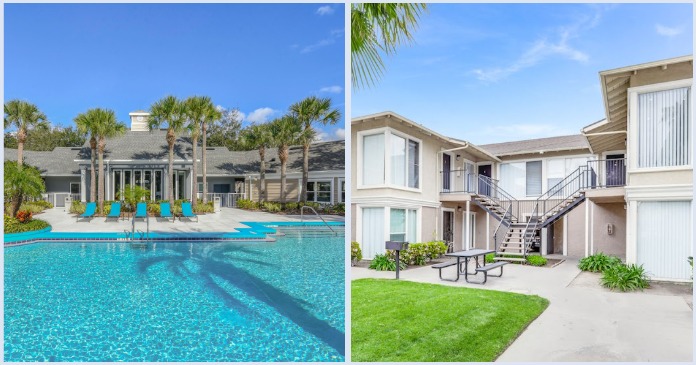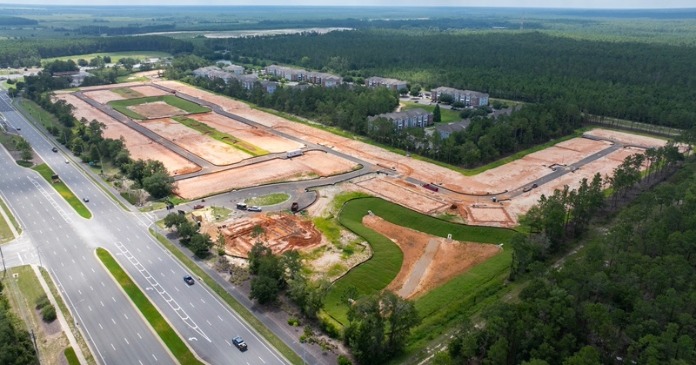Yield PRO TV presents Power Pros. Host Linda Hoffman talks with Vickie Rodgers, VPGM of Cox Communities.
Learn more about Cox Communities.
Transcript: NAHB Power Pros interview. Linda Hoffman with Vickie Rodgers, VP and general manager of Cox Communities, a division of Cox Communications based in Atlanta, recorded August 4, 2022
(music)
Linda Hoffman: Apartment owners and operators are just beginning to realize the financial payoff model on IoT within their facilities management. smart phones changed many things. Overcoming the great owner-occupant barrier known as split incentive was just one. Along the way many false starts were made in attempts to shoehorn multifamily into the single-family model. While the two sectors share a product—housing—they are far from sharing operational process.
Indeed, the multifamily business has a long and complex history. Sometimes we make great strides forward, such as utilizing aggregated, anonymized data. Sometimes it’s two steps back, as in rent moratoriums. But life is always simple in our minds: does it make financial sense and, if not now, when? Financial strategies around profitability are fundamental to our business but become even more essential as the economy tightens around us from every direction.
As we consider how to streamline our operations and harden our businesses to make it through the next economic cycle, the best answers are always found in proven models. A lot of data has been accrued across the multifamily sector in the last decade, especially related to energy consumption. But even before that, facilities and hospitality management were having great success in reducing operational costs and improving facility efficiency through smart technology. Many similar techniques have since found their way into multifamily operations and it is now a brave new world.
Here’s just one anecdote for historical perspective. Nearly a decade ago, the nation’s largest apartment management company was able to reduce utility costs across its rather diverse portfolio of properties by 43 percent with the use of smart technology. Today, anything including the word energy has taken on even greater significance, especially considering that utility costs are the second highest operational cost on a property running around 20 percent of overall expense. That’s real money.
Unlike a decade ago, technology is now a proven contributor to market performance. And technology is the key to unlocking profitability in all economic cycles.
Today’s guest understands multifamily housing asset performance with great clarity. Vickie Rodgers is VP and general manager of Cox Communities, a division of Cox Communications based in Atlanta. The company offers property owners bulk internet and video, managed wifi, and IoT services.
Vickie, it is great to have you on the show.
Vickie Rodgers: Nice to be here, thanks.
Linda Hoffman: What do we need to know about Cox and what exactly is it that brought you to the company?
Vickie Rodgers: Well you know I’ve been with the company about ten years, but I’ve been in the industry over 30 years. And I used to try to make that number sound bigger and now I now I try and make it sound smaller. But you know what I did is I came in and really centralized our multifamily strategy. And what we try to do for our customers, because these are long-term relationships for us, I mean we’ve had a lot of these customers for 20, 30 years and a lot of times the same teams work with the owners for years and years and years. And so, as we looked at what our value prop is and what we want to be our customers—we want to be a trusted advisor.
And so for us to do that, we really have to understand their business and what they’re trying to accomplish with maximizing occupancy, with maximizing rents, having a great resident experience and obviously future-proofing the property somewhat. And so the way we try to do that is we work really closely with the customers, understand what their business challenges are. We do joint research together, rank consumer interest in what causes the consumer to choose one apartment over the other and so forth.
But interestingly through COVID, so much has changed, right? So a lot of the properties were more IT laggards. They didn’t like, they were doing a lot of manual processes with, you know, with their maintenance staff and with leasing agents. You know, they may have a maintenance guy go and rekey locks or go walk the apartments and turn the thermostats down, you know, open apartments, etc.
And I tell you now, we just had a customer come in with his team yesterday and we spent the whole day with them, and you know, a lot of these guys, they have 30 percent below staffing and they can’t get enough maintenance people, especially with HVAC and other things. And so they’re like, hey, help us understand how we automate some of these processes so we can control it from anywhere and, you know, we can do it in a moment or with preset routines versus our folks having to walk around to each apartment because that just doesn’t work for the them anymore.
It’s important. We feel like if we try to help them reach their business goals then, and if it’s a win for the consumer or a win for the owner or a win for us, then it’s going to be successful and that’s kind of our mantra.
Linda Hoffman: Internet connectivity, especially at apartment properties, has seen a sea change over the years. What are the latest advancements and what advantages do they bring owners?
Vickie Rodgers: You know, a lot of times now owners are starting to monetize broadband and the reason they’re doing that is not that they want to be in the middle of the telecom business, it’s because, you know, 30 to 40 percent of their residents now work from home, typically 3-plus days a week. And so, you know, the apartment is not just a place to sleep anymore. It’s, a home is everything, right? And so it’s work from home, it’s school from home, it’s… some of the communities, too, where it’s renting by choice for folks my age and a little bit older, it’s aging in place, right? They don’t want to have the maintenance of a big house anymore. They want to be able to have remote health care and some of the other applications that are out there. And so home is becoming more important and as I was talking to my customer yesterday, he goes, you know, used to, if we got a trouble ticket it sounded like this, now it’s like, “look, I’m having an issue and you’ve got a come now because I’m working out of my house and here’s what’s happening.” And he’s right, you know.
You have to have always up-time. You have to have great up and down speed, and you know, to make sure it’s always on because it’s not a best-case SLA (service-level agreement). It needs to be up all the time because they’re doing their work from home. And so, it becomes a much bigger deal.
Linda Hoffman: Internet connectivity—and most importantly—reliability as you said Vickie, is central to a property’s operational resiliency. Tell us how Cox addresses market conditions and risk, and what competitive advantage does it offer business owners?
Vickie Rodgers: Well, you know we invest a huge amount into our network. And thank goodness we do and the way we do conjecture congestion control because if you look at when everybody went home to work, data usage went through the roof. And so we literally grew traffic—what would normally be a five or six year growth for us—within six months.
And so we’re constantly monitoring, you know, never getting above a 70 percent congestion, making sure we’re having certain kind of turnaround times, and reliability, etc. And you know, like you said, you know, if you go back and you think of National Multi Housing Association research they used to do, they always looked at the amenities, right? And I can remember, it wasn’t that long ago that, you know, internet was like 10 or 15 on the list. Now it’s number one. And we did some recent research that said 58 percent of tenants that are looking for an apartment will check what speeds are available, and what’s available on property, from not only internet from within the home, but what’s available in the common areas, in the pool, etc. and then also cell phone coverage, right, to make sure your cell phone’s going to work because that’s a key driver. Technology is a key driver of how they choose a similarly situated location for apartments. So obviously location’s important, close to school or work, but beyond that when you have two apartments that are exactly the same, the technology is the driver that makes the difference.
And it can be a difference of as much as—the research we did said 8 to 10 percent. I’ve seen some Park’s Research or other research that said sometimes with full automation and green initiatives it can be as much as 15, which is a pretty high number.
Linda Hoffman: I think it’s, as you mentioned, as important to residents as it is to owners… to run their systems. As I understand it… there are generally three types of IoT: The residents’ IoT where they own and control it. Home IoT where the property owners own it, but residents operate it. And facilities IoT where the owners own and operate it. How does Cox address these three very different systems’ needs, and where is speed, reliability and bandwidth most important?
Vickie Rodgers: So what we’ve developed is a product that we would integrate into the backend property management system, so if you had Yardi or Resman or whatever, so we integrate into the back. And what would happen is that software would allow that when Yardi says it’s unoccupied, so someone’s terminated their lease and they’ve got a moveout date, it would go to property control. And so the property typically would set pre-sets schematics.
So they would say, you know what, if I had an open apartment, during the day for certain months of the year I’ll have the temperature to be X. You know, change that to Y at certain times. Lock the doors at certain times or they could do preset areas so that, hey, I’m going to allow a paint crew to come in from 10 am to 2 pm. You know, give them a temporary pass code that they can get in during those times. Make that passcode go away after they’re gone so that it’s a revolving code.
When someone moves into the apartment, the control goes back to the resident and it’s controlled from their phone. And so when they sign a lease, information will go straight to the phone and they will know what their code is and then they can control, you know, their digital door lock, thermostat control, lights. Also, they would have water sensors in case you have water leakage. Because if you think it as an owner, one of the top five budget items for many apartment buildings is water damage, and so to be able to get an early indicator that something’s wrong so that they can take action, it keeps them from, you know… I think the average incident is 10 or 11,000 and honestly, big properties, 10 or 11 thousand isn’t that much, but if you have a lot of them, those add up. And if you can avoid it, you know, it’s a great savings obviously.
And so what we do is we allow the resident have control with their phone when they are, there’s an active lease. There are parameters and owner consent from, to never get hotter than X in Arizona, never to get colder than Y so you don’t bust pipes, you know in colder climates. If the HVAC is running rough, we would have, you know, as email sent directly to the maintenance crew or it could come on a log list that somebody just pulls down and does once a month. Or battery low would be another one that you could indicate off of that.
And so it will send certain messages to maintenance just for awareness and then, but the resident will control it when they lived in the apartment. When it’s an unoccupied unit the control shifts, like I said, to the property and then it’s a Class A solution, so if I’m Camden and I have someone in Dallas, and, but I need to control something in Houston, I can. I can do it off of a user dash board—it shows me what’s happening from a usability, in every property and I could intervene, if I needed to, or open apartments remotely, which is great.
Like it, think about it, in the past, some of the folks who used to work for me to work in apartment buildings and they have some great stories of crazy things that happened, right? But, someone needs access to the apartment. It’s 2 am. They’ve lost their key and you’ve got to go rekey it and get out there, right? Whereas if you have a digital door lock you just reset the door code and send it to them so much easier process.
With leasing staff being so skinny right now, and maintenance staff, it takes a lot of stress off your employees, it also makes for a better resident experience when they can just handle it themselves without having to do anything else. Also, you know, if you have your brother coming into town and he won’t have access into your apartment until you get there, you can give him a code, or the dog walker. You know, or if you have a maid coming in or anything else, it just makes things easier.
Linda Hoffman: You had mentioned upwards of 30 percent work from home residents…
Vickie Rodgers: At 30 to 40 percent now usually work from home three days plus per week and so some people have gone back in the office but not full time, right? And so, you know, there for a while everybody was working full time from home, but even now that some companies have gone back, they’re usually on flexible time. And so at least 40 percent of them at least work three days a week out of their apartment. And that changes everything, right, of how they interact with their leasing agents in the front office. They put in more tickets when they’re home, right? So, you’ll have more trouble tickets or other issues they want handled if they’re sitting in their house looking at things and they know they need something done.
Linda Hoffman: It might seem obvious, but what has remote work done to raise the importance of providing fast reliable internet service to apartment residents?
Vickie Rodgers: Well if you think about it, years ago when I started my career I sold to small businesses, right? So, I was BtoB sales in telecommunications. And you come to these offices and they may have 10, 15 and 20 devices in a LAN (local area network), right? Now our homes look like that. So, if you think about all the devices we have and all the connectivity, your home really looks like a small business in the complexity of that. And so it just changes what people expect, and you know, when you’re working from home or your kids are schooling from home, and I have an example.
You know my sons are in college, but some of their courses are remote and they go to school here locally. So, if I’m sitting here on a Teams call for work, because I work out of my house part of the time, too, and they’re in a class—you gotta make sure your up speed is good on your internet and that you don’t have an outage.
One of the things that we’re working on right now is fail-over, right? And so, one of the things we used to do for small businesses is, if you had an outage, you had a fail-over plan so that it never actually went down. So, we are launching our mobile services, and you know, cell phones. So, we’re going to have it set up so that if your broadband did take a hit or somebody cut a fiber or something happened, it would fail over to your wireless connection with your wireless phone, which is a nice back-up, right?
And so, you know, protection services. The other thing is security. You know, it’s amazing if you think about all the stuff people are doing off their laptops and their cell phones from their homes. We didn’t do that 20 years ago. You didn’t do online banking. You didn’t use your credit card online to purchase and have groceries delivered to your home or all these things, right?
And so security is really important and so making sure that the company you’re doing business with—especially if you are the provider of broadband and it’s a bulk service—that you’ve got the security applications that if you get a DOS attack that you don’t have something bad happen. Especially if you have digital door locks or if you have cameras or other things. You don’t want somebody to be able to get in that and then as an owner, you have to be in the middle of that.
So, security is key. Fail-over, you know a lot of people looking at managed wifi and building fiber and you know, that DOCSIS technology (Data Over Cable Service Interface Specification) with the cable providers provides one gig pretty much across the footprint today in any home that is covered by that. So, that’s incredible.
I can remember when I started my career selling one-gig services to a bank and charged them $10,000 a month. And now, you know, you can get one gig in your home for 60 or 70. It’s pretty incredibly when you think about that/
Linda Hoffman: Apartment owners have an intense focus on ROI. I know this is a highly contextual question, but maybe provide a rough overview. Can you give us a fast calculation on the investment return on property automation?
Vickie Rodgers: You know, it depends on how much you want to put in. So I would give you, I would say most of the deployments we’ve done, the owners’ really looked at the operational efficiency and what they got out of it. They’ve usually ended up spending anywhere from $600 to $700 per door. But you can, I’ve seen some people spend a thousand or more. But that’s usually a really high-end apartment and you’re trying to get every bling that you possibly can. Usually the return on investment on that is about 18 months to two years depending on what your history has been.
But if you look at the reduction in cost of re-keying, you look at the reduction in costs of energy savings, of being able to turn down or up thermostats on open apartments, if you look at the ability to mitigate risk on water leakage or frozen pipes—in some, it depends on the region of the country, frozen pipes can be a big deal in a lot of areas and then you look at just labor savings from what the maintenance crew or leasing agent would’ve done… you know, self-guided tours is huge. Now with our platform, our customers use self-guided tours, and at first we built that because it was an emergency. They’re like, look, it’s COVID, we can’t have somebody go around with them, can you build this and we did. And at first they said, hey, we’re just going to use this temporarily. But what they found is people start coming before hours to see apartments, and some of our apartment buildings tracked this and said they were getting 60 percent more close rate on the ones that self-tour—which is counterintuitive—than the ones that came with leasing agents. So, they said, we’re not going to stop this. We’re going to continue to offer this so that people can come outside of our hours that we can staff for. And we’re going to leave it as just one of the ways that you can tour the apartments.
We have some folks that are actually trialing AI because they are centralizing some of their calls, when people call in about apartments where they just ask them the questions and then it directs them to an interactive site, which is pretty incredible. I mean that technology has changed so much. We do not offer that yet, but I’ll tell you, it’s amazing when you see it demonstrated versus where it was five or six years ago. I mean you think you’re talking to a live person. It’s pretty amazing.
So at the high level, we’re seeing it drives about… I’ve seen it as low as 7 percent up as high as 10 to 11 percent in operational efficiency, which is huge. I mean when you’re thinking about the net operating income, that’s a big deal. But it does take probably a year and a half to two years to recap the capital investment up front.
Linda Hoffman: What a great show, Vickie. Thank you so much for joining us.
Vickie Rodgers: Oh, thank you. Thank you. It is an incredible space, the last few weeks I’ve talked to several customers and people are struggling to keep employees. It’s just terrible right now. And the automation, the technology’s so much better than it used to be. And, but I think we wouldn’t have gone as quickly as we had if it had not been for COVID. I think it forced us to develop things quicker. I think it forced customers to say, I’ve gotta have something. And so I think that sped things up. You know.
Linda Hoffman: Well, it’s certainly a wide blue ocean of opportunity for apartment owners and operators that didn’t exist just a short time ago. We appreciate your ability to provide clarity.
Apartment operations are a complex eco system… with multiple clients. There’s the resident of course, who seeks ever faster internet speeds, reliability at all times, and a full line up of entertainment and gaming-level service. Then there’s the property owner who must keep pace with a growing world of automated processes requiring reliable, secure and resilient service. Navigating this world is critical to any business, but most especially when the business must integrate residential and owner networks. Strategic partners with experience and knowledge are important to any operation—but with internet connectivity becoming as mission critical as any other utility, it’s easy to see the payoff of having a solid partner.
Read more about Cox Communities, a division of Cox Communications and its IoT white paper at YieldPro.com.
Thank you for joining us today. See you on the next episode of Power Pros.
(music, close, credits)
Power Pros (logo)
Yield Pro TV (logo)
An Image Production
Host Linda Hoffman
Executive Producer Andrew Nicks
Research Michael Rudy
Production Image
Yield Pro TV is a production of Multihousing Professional magazine corporation and may not be reproduced or copied in whole or in part without the expressed permission of the publisher.
©2022 Yield Pro, LLC.







